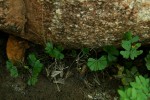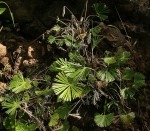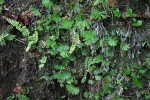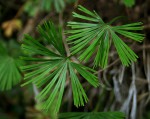Actiniopteris radiata (J. Konig ex Sw.) Link
Synonyms |
Actiniopteris australis sensu Sim |
|---|---|
Common name |
|
Description |
Rhizome shortly creeping, c. 4 mm in diameter; rhizome scales narrowly triangular, pale brown with a central dark stripe, 3-3.5 mm long. Stipe pale brown to strawcoloured, subglabrous with few brown hairlike scales. Fronds densely tufted, erect, weakly dimorphic, differing only in size and stipe length not in shape and degree of lamina dissection. Lamina flabellate, semi-circular in outline, dried lamina bent over sharply at an angle of 90° or more with the stipe. Sterile frond: stipe 2-10 cm long, lamina 1.5-4.5 cm long, dichotomously divided into 20-60 linear segments, segments apices serrate with 2-5 teeth, margins entire, usually reflexed. Fertile frond: stipe 5.5-20 cm long, lamina 3-7 cm long, otherwise similar to sterile lamina. Sori in submarginal lines, partly obscured by reflexed margin; indusium continuous. |
Notes | Can be confused with Actiniopteris dimorpha. A. dimorpha is strongly dimorph, fertile and sterile fronds differing in size and stipe length, as well as in shape or degree of lamina dissection. A. dimorpha also has about half the number of segments on the fertile frond. |
Derivation | radiata: describing the radiating arrangement of the segments of the lamina. |
Habitat | Dry rocky outcrops, in rock crevices, at base of boulders, on shallow soil overlying sheetrock, earth banks in shaded ravines. |
Distribution worldwide | Africa and eastwards through Arabia to India and Sri Lanka. |
Distribution in Africa |
Angola, Benin, Botswana, Chad, Dem. Republic of Congo, Djibouti, Egypt, Ethiopia, Kenya, Malawi, Mali, Mozambique, Namibia, Nigeria, Somalia, South Africa, Sudan and South Sudan, Swaziland, Tanzania , Togo, Uganda, Zambia, Zimbabwe. |
Growth form |
Lithophytic, terrestrial. |
Literature |
|




